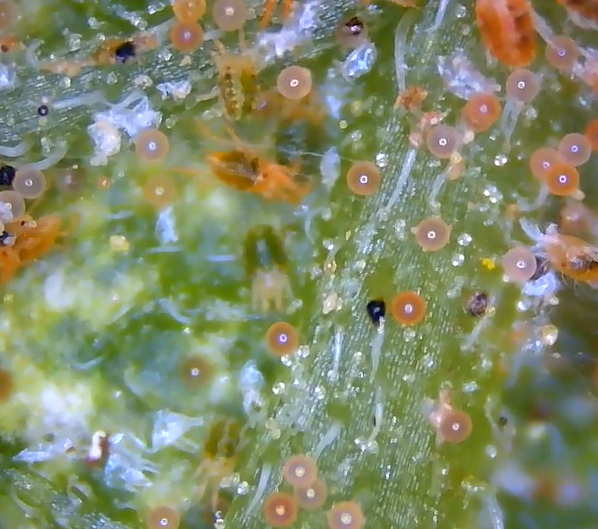
Here's some Christmas baubles for you!
Actually, they're Spider Mites filmed with my new digital microscope. As I learn more about microscopy, the videos and pics will improve, so bear with me! The new microscope has opened my eyes to the dance of pest and predator in our garden and I'll happily share images and videos here in the future.
These mites were filmed living on one of my sacrificial Solanum nigrum plants.
Sacrificial plants (no, they don't have to be virgins) are a great way to monitor and control your pests. All you do is leave one or two of a batch of plants untreated when you apply your favourite pest control method.
They will quickly become infested with whatever's around and as they become damaged and weak, will attract even more pests because, thinking ecologically, unless they're in plague numbers and competing for very limited resources, pests are here to remove the sick and weak plants.
Observe your sacrificial plants too for signs of predators such as the Ladybird Beetles who were too fast for me to film! Predators are usually quick and aggressive so at this stage, getting one on film is proving tricky...
Once you see predators around, destroy your sacrificial plants (yes, you'll take out a few predators but their presence indicates that they're already in your garden) and the pests thereon.
It's a challenging form of pest control. As you observe the buildup of pests, it's tempting to pull out the plants immediately but persevere and observe. I've learned heaps about the balance of things by using this technique.
When you know that predators are present, you can stop your regular pest control routine for that kind of plant because it will kill off the predators too. Do this and you'll see great results in the way of healthier plants, less poisons, less expense and best of all, less labour! Hooray!
The current HiveBuzz proposal will expire in a few days.
Do you mind supporting our proposal for 2022 so our team can continue its work next year?
You can do it on Peakd, ecency, or using HiveSigner.
Thank you. We wish you a Happy New Year!Dear @ligayagardener,
Done! keep up the good work!
The HiveBuzz team wishes you all the best for 2022! Have a Happy New Year ✨🥂✨
I love this pest control method! I may have to try it. I've never actually a ladybug devour any pests, though I know they do... I want to attract many more insects to the garden next year!
Looking forward to seeing some more awesome macro shots!
Ladybug larvae are voracious eaters and often do their job out of sight. As long as you have ladybugs, pests are being eaten!
I'm looking forward to posting many more shots!
Your content has been voted as a part of Encouragement program. Keep up the good work!
Use Ecency daily to boost your growth on platform!
Support Ecency
Vote for new Proposal
Delegate HP and earn more
Thanks!
Ahaha good one. I never thought about this method. I don't use pest control normally and never seem to have an issue except for cabbage moths. I think my chooks do a good job of most things. I tend to leave a lot of plants in to flower but maybe the balance is reasonable in my garden. However tons of tiny thrips this year. And mozzies.
Thanks It's really horses for courses. If you lety plants go to flower, it will attract lots of beneficial insects and you don't have to worry much about pest control. Chooks are the ultimate pest controllers!
There you go, I'm doing the right thing by accident!
that's the best way! I often do that then if it works I write about it so that it sounded like I knew what I was doing!😁
That's pretty incredible to watch. What are the little orange blobs, do you know? Also, were the speedy ladybirds the little black ones?
Thank you for going into more detail on utilising sacrificial plants. I've often wondered exactly how they are best used.
Thanks @minismallholding! The little round blobs are eggs and the little black blobs in the video are caterpillar poo.
The Ladybird beetles were just too fast for the moment